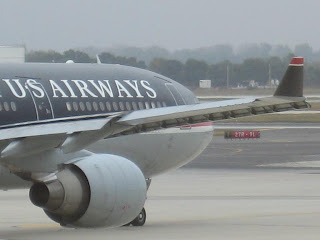The Boeing 757 is the smallest aircraft used by US Airways for its long-haul operations. The one depicted below is quite special as it has been tailored for Transatlantic operations. It has been certified under the Extended-range Twin-engine Operational Performance Standard and comes under the designation of B757-200ET to allow for operations above oceans far away from diversion airports. This is a mandatory requirement as long as flights are more than sixty minutes away from any usable airport.
Dark picture but with thunderstorms all around, skies were dark
ETOPS certification makes things a lot easier for airlines operating over the North Atlantic as diversion airports are few and far in between. Once over the Atlantic, the closest airports are Hamilton in Bermuda, Narsarsuaq in Greeland, Keflavik in Iceland and Lajes in the Azores.

Wingletted 757 plugged on an auxiliary air conditionning system
The other thing that makes this Boeing 757 special is the installation of blended winglets designed by Aviation Partners. The 757 is capable of crossing the Atlantic range-wise but not by a very large margin. This is why airlines mostly use the 757 between the North-East coast of the US and North-West Europe. However, in order to account for strong jetstreams during the Winter and to operate the aircraft further inside Europe, airlines have added winglets that slightly improve fuel consumption and range for long operations.
Boeing 767-200
I was pretty happy to find a load of Boeing 767-200 at Philadelphia as these aircraft are slowly being retired and therefore are more and more difficult to spot. Most of them have already been retired and few airlines still operate them. Continental Airlines, American Airlines and US Airways are the largest operators of the type now but they already plan to phase them out in the coming years.

The Boeing 767-200 was the first aircraft of the 767 production line in Everett, WA. However most of the 767 production consisted of the stretched 767-300 and 767-300ER. US Airways still operate the early-built 767-200ER which features a somewhat higher gross weight and most importantly more fuel capacity.

Pushed back and starting the hairdryers
This version of the 767 is the second longest-range aircraft in US Airways fleet despite serving chiefly the airline for more than fifteen years. However, at the time the airline bought the airplane, operations to Europe were not planned and the airline decided to go with a rather low maximum take-off weight - 330,000lbs - thus tremendously limiting the range-payload envelope of the aircraft. This saddly reduces the capabilities of an otherwise very capable airplane. As a result, US Airways uses them mostly to serve its high capacity routes in western Europe.

The new color scheme is both classy and very curvy
After being towed away from the international pier, this 767 starts its own General Electrics CF6-80C2 engines and is about to go on its own power for another ride above the Pond.
Airbus A330-300
The Airbus twin widebody is the largest aircraft in US Airways fleet. It is also the yougest with deliveies starting in the late 90's. The A330 is used to serve core European destinations as well as Star Alliance partners hubs. I got lucky enough to find this one in the so called old new paint scheme that will slowly disappear in time.

This one was aimed for Star Alliance hub in Frankfurt. It stayed for several minutes at the gate after the jetway was removed in order to unload some baggage of no-show passengers. Some people will never get it...

Starting those massive Pratt&Whitney 4128 turbofans

Getting read for an eight hour flight over the Pond to Frankfurt am Main.
While awaiting for taxi clearance and experiencing the usual ATC delays at Philly, the aircraft starts its engines and extends the flaps and slats. Notice the ailerons tilted down and used as flaperons for take-off.
As a bonus, a pre US Airways-America West merger paint scheme on this A320. Radio callsign for America West aircraft was Cactus.
Cute?
.
That's it for a short description of US Airways long-haul fleet. By the way, did I mention that ETOPS also stands for Engines Turn Or Passenger Swim... ?
.



No comments:
Post a Comment